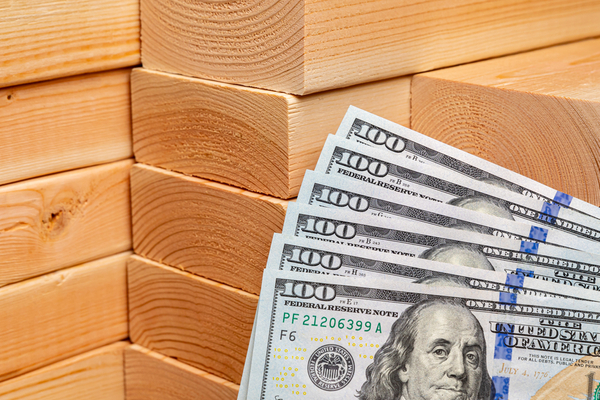Better Homes & Gardens reports that with many people taking advantage of historically low interest rates and building new homes, plus high demand for remodeling projects causing a shortage in lumber, many are finding that their projects are taking longer to finish. And for those with plans to do DIY projects that use lumber, setting a budget is a challenge. Over the past year, the cost of lumber has increased 430%—from $259 per 1,000 board feet of lumber to over $1,300, according to Fixr, a home remodeling resource.
“As the price continues to change, it is becoming difficult to budget how much certain remodeling may cost,” says Adam Graham, construction industry analyst at Fixr. While you might have to wait on certain renovations that don’t fit your budget with today’s soaring lumber prices, there are still ways to complete your DIY projects—you just have to get a little creative. Here are some expert tips on navigating high lumber prices and what you can do to find more affordable options.
- Plan ahead with a SOW.
Before you start your project, come up with a detailed plan. Jennie Berger, residential redeveloper and co-owner of Property People LLC, suggests drafting a scope of work (SOW). While this might not be the way you typically go about home DIYs, sticking to a solid, detailed SOW will help prepare you for the cost of the project. Include all the details of the project both big and small, item by item. If lumber will be a big part of your project, carefully mark and measure the lumber you will need so it doesn’t go to waste. “Knowing what you’re getting into ahead of time can really put the mind at ease,” says Berger. “The less surprises you encounter when you’re ready to dive in, the better.”
- Change the focus of your project.
According to a report by Wells Fargo economists, lumber costs are not expected to come down to their pre-pandemic levels anytime soon. So instead of canceling lumber-heavy projects on your list, like new cabinets or flooring, try refocusing. Graham suggests using paint to upgrade an area in your home that could use a little refresh. “Other material upgrades, like backsplashes or countertops in a kitchen, may be a more affordable option this year,” says Graham. DIY projects have more elements to them than lumber, so budget where you can to offset the costs of lumber.
- Use alternative materials.
The record-breaking prices of lumber might be an opportunity to use cheaper and more sustainable materials. Recycled wood used to be considered a premium material according to interior designer Kaitlin Barthold, but now that lumber prices are so high, it’s much more affordable, and there are plenty of great uses for reclaimed wood. “I strongly think that builders and the construction industry will be looking for any cheaper options,” says Barthold. “Bamboo is a great quick-growth option that can work for flooring.” She also suggests exploring cork, and Trex, which is a type of alternative lumber made from recycled plastic.
Barn wood or using wood from old buildings that is no longer needed is another sustainable and budget-friendly option. Gregory Kyler, licensed general contractor and co-owner of Property People LLC, suggests calling a local demolition company. “Ask them if they’re tearing down a house, and maybe they can sell you the materials off of it,” says Kyler. He says most lumber is engineered these days, so what you’re getting is a recycled material in itself.
- Shop around.
Check out local reclaimed wood stores in your area to save money on your DIY project. You can even shop for reclaimed and recycled wood on eBay, Craigslist, and Etsy. RockinWoodUSA sells reclaimed for DIYs on Etsy. You can also shop Overstock or Wayfair—Berger says you can often find the same materials there for 50% less than bigger retailers.
- If you’re going through a contractor, carefully review all documents.
If you have a bigger project that involves a contractor or remodeling company, make sure you thoroughly review all contracts. Because of the uncertainty around high lumber prices and when they will come down, many contracts are adding price escalation clauses. This means that the final cost of your project is subject to change if there are fluctuations in the price of materials during the project, leaving you with an unclear idea of your bottom line. Experts advise homeowners to look for any clauses that allow the builder to increase the price due to the cost of raw materials and identify when the contractor (and the homeowner) may cancel the contract if the price rises too much beyond the amount listed in the contract.
Lumber costs are at all-time highs and don’t show any sign of coming down anytime soon, but don’t cancel your DIY projects just yet. Explore all the options available to you so you can plan your budget accordingly and find more reasonable and sustainable ways to bring your vision to life.
—
Photo Credit: J.J. Gouin / Shutterstock.com
